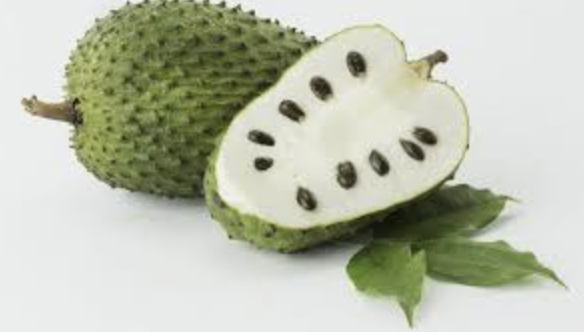Health Benefits of Soursop
Written by Jonn medical realities Reviewed by Jonn Rick on 21 august 2025

What Is Soursop
Soursop—aka guanábana, graviola, or sirsak—is a prickly green tropical fruit from a small evergreen tree native to Central and South America (you’ll spot it in Florida markets and Caribbean groceries across the U.S.). Picture an oval, spiky melon up to ~8 inches long and 10 pounds. Inside: white, fibrous flesh that tastes like mango + strawberry + pineapple with a citrusy vibe. Folks searching for soursop benefits or graviola benefits are usually talking about this exact fruit.
Nutritional Profile of Soursop
This isn’t just a tasty smoothie add-in; it’s a legit nutrient package.
- Vitamins: C, B1 (thiamin), B2 (riboflavin), B3 (niacin), folate
- Minerals: potassium, magnesium, calcium, iron, phosphorus, zinc, copper
One whole fruit (~1.3 lb) roughly provides:
Calories ~412 • Protein ~6.25 g • Fat ~2 g • Carbs ~105 g • Fiber ~21 g • Sugars ~85 g
Soursop Benefits
Soursop (fruit and leaves) comes loaded with antioxidants—phytosterols, tannins, and flavonoids—backing much of the buzz around soursop tea, soursop extract, and wellness routines.
Immune support
Big win on vitamin C: about ~129 mg per fruit (roughly ~170% of daily needs for women and ~140% for men). Vitamin C helps your immune system stay ready and neutralizes free radicals that can rough up skin and cells.
Digestive health
With ~21 g of fiber per fruit, soursop helps keep things regular and supports a healthy gut microbiome—handy if you’re trying to hit that 25–38 g/day target without living on bran cereal.
Antioxidants & inflammation
Oxidative stress can crank up inflammation. The antioxidant mix in soursop may help dial that down—think everyday support, not a miracle cure.
Blood pressure support
Potassium helps your body balance out sodium and ease vessel tension. A whole soursop can land you around a third to half of a typical daily potassium target, making soursop nutrition friendly for heart-smart eating.
Antibacterial notes
Extracts of Annona muricata have shown activity against certain bacteria in test-tube studies (including oral bacteria linked with gum issues). Cool science, but it’s lab data, not a green light to skip your dentist.
Blood sugar research
Animal studies suggest graviola extracts may lower fasting glucose and improve insulin signaling. We don’t yet know how that translates to humans, so don’t swap out prescribed meds based on headlines—loop in your clinician first.
Ulcer & GI support (early data)
Traditional use plus animal studies point to potential protection of the stomach lining and reduced acid load with soursop leaves. Again: promising, but human-grade evidence is still thin.
Weight-management signals (animal data)
In high-fat-diet mouse models, soursop leaf extracts were linked with less weight gain—without cutting calories. Interesting, but it needs human trials before anyone calls it a weight-loss hack.
Soursop in Traditional Medicine
Across the Caribbean, Latin America, and plenty of U.S. communities from Miami to SoCal, soursop (aka graviola, guanábana, Annona muricata) has a long folk-medicine résumé. Grandmother wisdom says the soursop leaves make a mellow soursop tea for all kinds of stuff: pesky bacterial or parasite infections, fever, high blood sugar, high blood pressure, inflammation, anxious vibes, coughs and asthma, tummy troubles, and general aches. You’ll also hear people chat about potential graviola benefits around cancer support—but that’s tradition talking, not a doctor’s prescription. Human studies haven’t proven soursop extract cures any of those conditions, so if you’re thinking supplements, loop in your healthcare pro first.
Soursop leaves benefits (what the lab says):
Dark-green, glossy leaves are loaded with antioxidants that help your immune system do its thing. In vitro (test-tube) work has explored connections with headaches, poor sleep, abscesses, ulcers, and certain cancers. Cool data, but still lab-stage, not real-world proof in people.
Possible side effects and cautions:
Like any botanical, there are trade-offs. High intake of soursop fruit or concentrated leaf tea has been linked in some research to nerve effects that can mimic Parkinson’s-like symptoms. The plant can also amplify certain meds—especially blood pressure or diabetes drugs—so your numbers could drop too low. And the big one: do not eat the seeds. They contain toxic compounds; always remove and toss them. If you’re on prescriptions or have chronic conditions, treat Annona muricata products like any supplement—run it by your clinician.
How to eat soursop (the tasty way):
You’ll spot fresh or frozen fruit at Latino/Caribbean markets, some national grocers, and farmers markets; you can also find soursop juice (100%) in the beverage aisle. Unripe fruit is firm and green; when it turns yellow-green and gives a little under your thumb, it’s ready. Ripen on the counter, then refrigerate and use within a few days.
Soursop tea: Rinse a few leaves, pour boiling water over them, and steep ~10 minutes. Sweeten lightly with honey if you like. This is the classic way folks enjoy soursop leaves without going heavy on extracts.
Raw: Slice, scoop the white flesh, remove every seed, and dig in. Great over yogurt or oatmeal, or blended into smoothies and popsicles.
Baking: Fold chunks into quick breads or simple snack cakes for a tropical twist.
DIY soursop juice: Peel, deseed, blend the pulp with cold water until smooth. Strain if you want it lighter, or keep it thick like a smoothie. Flavor to taste with lime, ginger, vanilla, or a touch of honey.
Soursop (Graviola) — U.S. FAQs
Straight-talk answers for American shoppers, home cooks, and wellness seekers.









